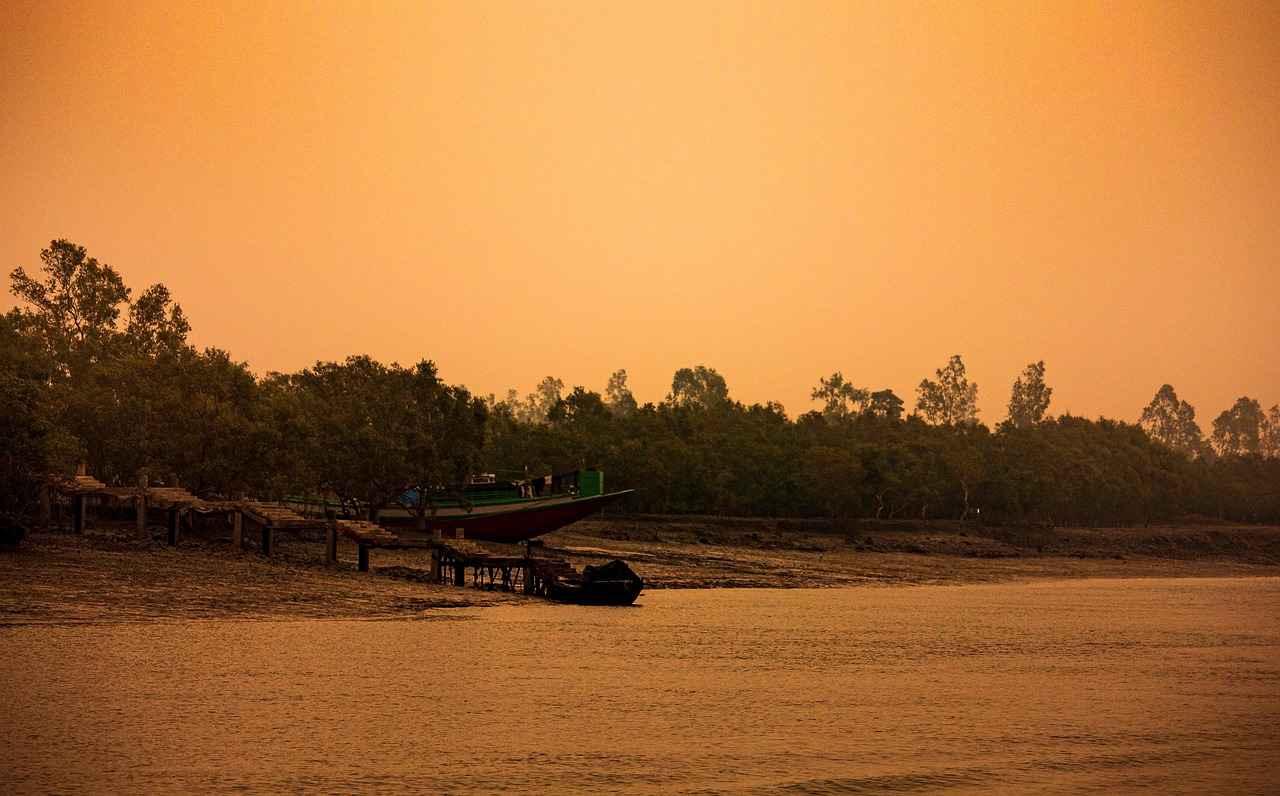This article delves into the stunning landscapes, rich biodiversity, and exciting activities that make West Bengal a top destination for both nature enthusiasts and adventure seekers. With its unique blend of natural beauty and cultural richness, West Bengal offers an experience unlike any other.
1. Diverse Ecosystems of West Bengal
West Bengal boasts a wide array of ecosystems, ranging from lush forests and wetlands to mountainous terrains. This ecological diversity is home to countless species of flora and fauna, making it a paradise for nature lovers.
2. The Sundarbans: A UNESCO World Heritage Site
The Sundarbans, recognized as the largest mangrove forest in the world, is a UNESCO World Heritage Site. It is renowned for its unique biodiversity, including the majestic Bengal tiger.
- Wildlife Spotting in the Sundarbans: Visitors can encounter rare species, such as the saltwater crocodile and various bird species, in their natural habitat.
- Best Times for Wildlife Viewing: The winter months are ideal for wildlife viewing, as animals are more active and visible.
- Guided Tours and Safaris: Expert-led tours enhance the experience, ensuring safety while exploring this vast wilderness.
3. The Himalayas: Adventure Awaits
The northern region of West Bengal features the breathtaking Himalayas, offering a plethora of adventure activities such as trekking, mountaineering, and river rafting.
- Popular Trekking Routes: Routes like Sandakphu and Phalut provide stunning views and a chance to experience the region’s biodiversity.
- River Rafting in Teesta River: The Teesta River is famous for its thrilling white-water rafting experiences.
4. Rich Biodiversity in National Parks
West Bengal is home to several national parks, such as Jaldapara and Buxa, which protect diverse wildlife and plant species, making them perfect for nature lovers and wildlife photographers.
- Birdwatching in Jaldapara National Park: A haven for birdwatchers, hosting numerous migratory and resident bird species.
- Exploring Buxa Tiger Reserve: Offers opportunities to spot elusive wildlife, enhancing the adventure experience.
5. Scenic Hill Stations
West Bengal’s hill stations, such as Darjeeling and Kalimpong, are perfect for those seeking tranquility amidst stunning landscapes and tea gardens.
- Tea Gardens of Darjeeling: A visual treat that also offers insights into tea production.
- Adventure Activities in Kalimpong: Activities like paragliding and mountain biking cater to thrill-seekers.
6. Cultural Experiences in Nature
The unique blend of culture and nature in West Bengal provides enriching experiences, from local festivals to traditional crafts.
- Local Festivals Celebrating Nature: Festivals often celebrate nature, providing opportunities to engage with the community.
- Traditional Crafts and Eco-Tourism: Engaging in crafts while exploring eco-tourism initiatives supports sustainable practices.
In conclusion, West Bengal stands out as a remarkable destination for nature lovers and adventure seekers. Its diverse ecosystems, thrilling activities, and rich cultural experiences make it a must-visit for anyone looking to connect with nature.

1. Diverse Ecosystems of West Bengal
West Bengal is a treasure trove of diverse ecosystems, making it a haven for nature lovers and adventure seekers. The state’s landscapes range from the lush green forests of the Eastern Himalayas to the expansive wetlands of the Sundarbans, each hosting a unique array of flora and fauna.
The rich biodiversity found in West Bengal is a result of its varied climate and geography. The region is home to dense forests, serene rivers, and sprawling wetlands, each providing a habitat for countless species. For instance, the Sundarbans mangrove forest is not only the largest of its kind but also a UNESCO World Heritage Site, known for its unique ecosystem that supports the endangered Bengal tiger and numerous bird species.
Moreover, the state features several national parks such as Jaldapara and Buxa, which protect diverse wildlife, including rhinos, elephants, and various avian species. These parks are perfect for wildlife enthusiasts and photographers looking to capture the beauty of nature in its purest form.
In addition to its natural beauty, West Bengal’s ecosystems offer a plethora of activities for adventure seekers. From trekking in the Himalayas to birdwatching in wetlands, the state provides endless opportunities for exploration. The hill stations of Darjeeling and Kalimpong are ideal for those seeking tranquility amidst stunning landscapes, while also offering thrilling activities such as paragliding and mountain biking.
In conclusion, the diverse ecosystems of West Bengal not only attract nature lovers year-round but also provide a rich tapestry of experiences for adventure seekers. Whether you are exploring the dense forests, navigating the rivers, or simply soaking in the breathtaking views, West Bengal is a destination that promises unforgettable encounters with nature.

2. The Sundarbans: A UNESCO World Heritage Site
The Sundarbans is a magnificent natural wonder that captures the hearts of nature lovers and adventure seekers alike. As the largest mangrove forest in the world and a designated UNESCO World Heritage Site, it is renowned for its breathtaking landscapes and rich biodiversity.
Spanning across India and Bangladesh, the Sundarbans is home to a variety of unique species, including the majestic Bengal tiger, which is the forest’s most iconic inhabitant. The region’s intricate network of waterways, mudflats, and islands creates a complex ecosystem that supports an array of wildlife, making it a prime location for nature enthusiasts.
| Key Features of the Sundarbans | Description |
|---|---|
| Size | Approximately 10,000 square kilometers |
| Biodiversity | Home to over 400 species of fauna and 300 species of flora |
| Endangered Species | Includes the Bengal tiger, saltwater crocodile, and various migratory birds |
Visitors to the Sundarbans can embark on thrilling wildlife safaris that offer the chance to spot not only Bengal tigers but also other rare species such as the saltwater crocodile and various birds. The best time for wildlife viewing is during the cooler months of winter, when animals are more active and visible.
Guided tours are available, providing expert insights into the ecosystem’s dynamics and ensuring a safe exploration of this vast wilderness. These tours often highlight the cultural significance of the Sundarbans, showcasing the local communities whose lives are intricately tied to this unique environment.
In conclusion, the Sundarbans mangrove forest stands as a testament to nature’s beauty and resilience. Its rich biodiversity and cultural heritage make it a must-visit destination for anyone seeking to connect with the wonders of the natural world.
2.1. Wildlife Spotting in the Sundarbans
Wildlife Spotting in the Sundarbans is an exhilarating experience that draws nature enthusiasts and adventure seekers from around the globe. Nestled in the heart of West Bengal, the Sundarbans is the largest mangrove forest in the world and a UNESCO World Heritage Site. This unique ecosystem is teeming with diverse wildlife, making it a prime location for spotting rare and endangered species.
The thrill of wildlife spotting in the Sundarbans is unmatched. Visitors have the opportunity to encounter the majestic Bengal tiger, which roams freely among the dense mangroves. These elusive creatures are known for their stealth and power, making any sighting a memorable event. Additionally, the Sundarbans is home to the saltwater crocodile, one of the largest reptiles on Earth. Observing these formidable creatures in their natural habitat adds an element of excitement to any expedition.
The region is also a haven for birdwatchers, with over 300 species of birds recorded in the area. From the striking kingfisher to the majestic white-bellied sea eagle, the variety of avian life is astounding. Early morning boat rides through the mangroves provide the best opportunities for spotting these feathered inhabitants as they take flight or perch on branches.
Best Times for Wildlife Viewing
- Winter months (November to February) offer cooler temperatures and increased animal activity.
- Early mornings and late afternoons are ideal for sightings, as animals are more active during these times.
Guided Tours and Safaris
To enhance the wildlife spotting experience, guided tours and safaris are highly recommended. These tours not only ensure safety while navigating the vast wilderness but also provide expert insights into the unique ecosystem. Knowledgeable guides share fascinating information about the flora and fauna, enriching the overall experience.
In conclusion, the Sundarbans is a treasure trove for wildlife enthusiasts. With its rich biodiversity, breathtaking landscapes, and thrilling opportunities for wildlife spotting, it stands out as an essential destination for anyone looking to connect with nature in its purest form.
2.1.1. Best Times for Wildlife Viewing
The Sundarbans, a breathtaking UNESCO World Heritage Site, is renowned for its rich biodiversity and unique ecosystems. Among the many wonders it holds, the best time for wildlife viewing stands out, particularly during the winter months.
From November to February, the weather in the Sundarbans becomes cooler and drier, creating optimal conditions for wildlife enthusiasts and photographers. During this period, animals are more active and visible, increasing the chances of spotting elusive species. The Bengal tiger, the crown jewel of the Sundarbans, is often seen roaming the mangroves, making it a prime time for those hoping to catch a glimpse of this majestic creature.
Moreover, the cooler temperatures drive many animals to the water’s edge, where they can be observed drinking and hunting. This behavior enhances the wildlife viewing experience, allowing visitors to witness the natural interactions among various species. The saltwater crocodile, for instance, can often be spotted basking on riverbanks, while a plethora of bird species, including migratory birds, flock to the area, creating a vibrant scene for birdwatchers.
To maximize the wildlife viewing experience, guided tours are highly recommended. Expert guides not only ensure safety but also provide valuable insights into the behavior and habitat of the diverse wildlife. These tours often utilize small boats, allowing for close encounters with nature without disturbing the delicate ecosystem.
In conclusion, the winter months are undoubtedly the best time for wildlife viewing in the Sundarbans. The combination of cooler weather, increased animal activity, and expert-guided tours creates an unforgettable experience for nature lovers and photographers alike. Whether it’s the thrill of spotting a tiger or the beauty of the mangrove landscapes, the Sundarbans during winter offers an unparalleled adventure.
2.1.2. Guided Tours and Safaris
Guided Tours and Safaris in the Sundarbans are essential for anyone looking to explore this magnificent ecosystem safely and effectively. The Sundarbans, a UNESCO World Heritage Site, is renowned for its rich biodiversity, including the elusive Bengal tiger and a variety of other wildlife species. With its complex network of waterways and dense mangrove forests, navigating this vast wilderness can be challenging. Therefore, joining a guided tour not only enhances your experience but also ensures your safety.
Expert guides lead these tours, offering insider knowledge about the local flora and fauna. They are trained to spot wildlife that many visitors might miss, providing a more enriching experience. Whether you are interested in birdwatching, photography, or simply soaking in the natural beauty, a guided safari can cater to your interests. The guides share fascinating stories and facts about the ecosystem, helping you understand the delicate balance of life in the Sundarbans.
Additionally, these tours prioritize environmental conservation. By participating in guided safaris, you contribute to sustainable tourism practices that protect the wildlife and their habitats. Many tour operators follow strict guidelines to minimize their impact on the environment, ensuring that the pristine beauty of the Sundarbans is preserved for future generations.
Moreover, guided tours often include safety measures, such as the use of safe boats and trained personnel who are familiar with the terrain. This is particularly important in an area like the Sundarbans, where sudden changes in weather can occur, and wildlife encounters can be unpredictable. With a knowledgeable guide, you can feel secure while fully immersing yourself in the adventure.
In conclusion, guided tours and safaris in the Sundarbans are invaluable for both novice and experienced nature lovers. They provide a unique opportunity to explore this incredible region safely, while also fostering a deeper appreciation for its ecological significance.
2.2. Cultural Significance of the Sundarbans
The Sundarbans, a UNESCO World Heritage Site, are not only a breathtaking natural wonder but also a vibrant tapestry of cultural heritage. The local communities residing within this unique ecosystem have developed traditions and lifestyles that are intricately linked to their environment, showcasing a profound respect for nature.
These communities, primarily comprising Bengali fishermen and mangrove dwellers, have adapted their ways of life to the rhythm of the tides and the cycles of wildlife. Their reliance on the Sundarbans for fishing, honey collection, and other resources has fostered a deep connection with the land, leading to the preservation of traditional practices passed down through generations.
One notable aspect of their culture is the celebration of local festivals, which often revolve around the changing seasons and the abundance of natural resources. For instance, the Ganga Sagar Mela is a significant event where thousands gather to celebrate the confluence of the Ganges and the sea, highlighting the community’s spiritual bond with water.
Moreover, the Sundarbans are home to a rich tapestry of folk traditions, including music, dance, and storytelling, which reflect the community’s experiences and relationship with nature. The Baul singers, known for their mystical songs, often draw inspiration from the surrounding landscape, weaving tales of love and nature that resonate deeply with both locals and visitors.
Additionally, the local artisans create beautiful handicrafts using materials sourced from the forest, such as jute and mangrove wood. These crafts not only provide a source of income but also serve as a reminder of the sustainable practices that the communities uphold.
In conclusion, the Sundarbans are a living example of how nature and culture can coexist harmoniously. The unique traditions and lifestyles of the local communities are a testament to their resilience and adaptability, making the Sundarbans a remarkable destination for those seeking to explore the intersection of nature and cultural heritage.

3. The Himalayas: Adventure Awaits
The northern region of West Bengal is graced by the majestic Himalayas, a breathtaking landscape that beckons adventure enthusiasts from all corners of the globe. This area is not just about stunning views; it offers a multitude of adventure activities that cater to thrill-seekers and nature lovers alike.
From the exhilarating heights of trekking to the adrenaline rush of river rafting, the Himalayas provide an array of opportunities for those looking to immerse themselves in nature’s splendor. Here’s a closer look at what this magnificent region has to offer:
- Trekking Adventures: The Himalayas are home to some of the most popular trekking routes in the world. Notable trails such as Sandakphu and Phalut offer trekkers stunning panoramic views and the chance to encounter diverse flora and fauna along the way.
- Mountaineering Challenges: For the more adventurous, the region presents opportunities for mountaineering. The challenging terrains and high altitudes provide a thrilling experience for both seasoned climbers and beginners.
- River Rafting on the Teesta: The Teesta River is famous for its white-water rafting, attracting adventure enthusiasts eager to navigate its thrilling rapids. With varying levels of difficulty, it caters to both novices and experienced rafters.
Each of these activities not only offers a rush of adrenaline but also a chance to appreciate the breathtaking beauty of the Himalayas. As you trek through the lush green valleys or navigate the challenging rapids, you will be surrounded by stunning landscapes, including snow-capped peaks and serene rivers.
In conclusion, the Himalayas in West Bengal are a treasure trove for adventure seekers. Whether you are trekking to the highest points or rafting down the rushing rivers, the experiences you gain will be unforgettable, making this region a must-visit for anyone seeking adventure in nature.
3.1. Popular Trekking Routes
Discover the Thrills of Trekking in West Bengal
West Bengal is a haven for trekking enthusiasts, featuring a range of stunning routes that showcase the region’s natural beauty and diverse ecosystems. Among the most sought-after trekking destinations are Sandakphu and Phalut, both of which offer breathtaking vistas and an immersive experience in nature.
Sandakphu Trek: The Sandakphu trek is renowned for its panoramic views of the majestic Himalayan peaks, including the iconic Kanchenjunga and Everest. As trekkers ascend to an altitude of 3,636 meters, they are treated to a mesmerizing landscape filled with rhododendron forests and vibrant alpine meadows. The trek typically spans over four to five days, allowing adventurers to soak in the stunning scenery and rich biodiversity along the way.
Phalut Trek: Just a stone’s throw away from Sandakphu, Phalut offers equally captivating views and a slightly less challenging trail. This trek is perfect for those looking to enjoy a tranquil experience amidst nature. The route is adorned with lush greenery, and trekkers can often spot unique flora and fauna, making it a paradise for nature lovers and photographers alike.
| Trekking Route | Altitude (meters) | Duration (Days) | Highlights |
|---|---|---|---|
| Sandakphu | 3,636 | 4-5 | Views of Kanchenjunga and Everest, Rhododendron forests |
| Phalut | 3,600 | 3-4 | Tranquil landscapes, diverse flora and fauna |
Both treks are not just about the destination; they offer an opportunity to connect with the local culture, as trekkers often encounter remote villages and interact with the indigenous communities. This adds a unique dimension to the trekking experience, enriching it with cultural insights and stories.
In conclusion, the trekking routes of Sandakphu and Phalut in West Bengal are perfect for adventure seekers looking to explore breathtaking landscapes and diverse ecosystems. Whether you are an experienced trekker or a novice, these trails promise an unforgettable journey through the heart of nature.
3.2. River Rafting in Teesta River
River Rafting in Teesta River is an exhilarating adventure that draws thrill-seekers from around the world. Nestled in the scenic landscapes of West Bengal, the Teesta River offers some of the most exciting white-water rafting experiences, characterized by its turbulent rapids and stunning surroundings.
The river flows through the majestic Himalayas, providing a breathtaking backdrop for adventurers. With rapids ranging from grade II to grade IV, the Teesta caters to both beginners and experienced rafters. Here’s what you need to know about this thrilling activity:
- Best Time to Go: The ideal time for rafting in the Teesta River is between September and December, when the water levels are perfect for a thrilling ride.
- Safety First: Always choose a reputable rafting company that provides safety gear and experienced guides. Safety briefings are essential before embarking on your adventure.
- What to Expect: Expect an adrenaline-pumping experience as you navigate through the rapids, with opportunities to enjoy the serene beauty of the riverbanks in between the thrilling sections.
Many rafting tours also include additional activities such as camping and trekking, allowing adventurers to immerse themselves in the natural beauty of the region. The experience is not just about the thrill; it is also about appreciating the stunning landscapes and diverse wildlife that call this area home.
In conclusion, river rafting in the Teesta River is not just an adventure; it is a journey through nature’s wonders. Whether you are a novice or an experienced rafter, the Teesta offers an unforgettable experience that combines excitement with breathtaking scenery.

4. Rich Biodiversity in National Parks
West Bengal’s national parks are a treasure trove of biodiversity, offering incredible opportunities for wildlife enthusiasts and photographers alike. Among these parks, Jaldapara and Buxa stand out for their unique ecosystems and rich wildlife.
West Bengal is home to several national parks that protect a wide array of wildlife and plant species. These parks not only serve as sanctuaries for endangered animals but also provide a habitat for numerous flora and fauna, making them a must-visit for nature lovers and wildlife photographers.
Jaldapara National Park is renowned for its vibrant avian population. Home to over 200 species of birds, it attracts both migratory and resident birds, making it a prime location for birdwatching enthusiasts. The park is particularly famous for the great Indian one-horned rhinoceros, which can often be spotted in its natural habitat.
- Best Time to Visit: The ideal time for birdwatching in Jaldapara is during the winter months when migratory birds flock to the park.
- Photography Opportunities: Early mornings and late afternoons provide the best lighting for capturing stunning wildlife photographs.
Buxa Tiger Reserve offers a rich tapestry of dense forests and diverse wildlife. This reserve is home to the majestic Bengal tiger, along with other species such as elephants and leopards. The park is also a biodiversity hotspot, with numerous plant species that are endemic to the region.
Wildlife You Might Spot:- Bengal Tiger- Asian Elephant- Clouded Leopard- Various Bird Species
Visitors can enjoy guided tours that provide insights into the ecosystem while ensuring a safe and enriching experience. The trails through the reserve offer opportunities for both wildlife spotting and photography, making it a perfect destination for adventure seekers.
In conclusion, West Bengal’s national parks, particularly Jaldapara and Buxa, offer unparalleled experiences for nature lovers and wildlife photographers. With their rich biodiversity, these parks are essential for conservation efforts and provide a unique glimpse into the region’s ecological wealth.
4.1. Birdwatching in Jaldapara National Park
Birdwatching in Jaldapara National Park is an enthralling experience that attracts both amateur and seasoned ornithologists. Nestled in the Alipurduar district of West Bengal, this national park spans over 216 square kilometers and is renowned for its rich biodiversity and stunning landscapes.
The park is home to a plethora of bird species, both migratory and resident, making it a true birdwatcher’s paradise. Among the notable avian inhabitants are the great hornbill, white-bellied sea eagle, and the vibrant Indian roller. Each season brings a new wave of migratory birds, enriching the park’s already diverse ecosystem.
Visitors can explore the park through well-marked trails and guided tours, which enhance the birdwatching experience. The best time to visit is during the winter months, when migratory birds flock to the area, providing a unique opportunity for bird enthusiasts to observe rare species in their natural habitat.
| Best Birdwatching Months | Notable Bird Species |
|---|---|
| November to February | Great Hornbill, Indian Roller, White-bellied Sea Eagle |
| March to June | Various Migratory Species |
In addition to birdwatching, Jaldapara National Park offers a chance to witness other wildlife, including the majestic Indian elephant and the elusive one-horned rhinoceros. The park’s diverse habitats, ranging from grasslands to dense forests, create a perfect setting for observing wildlife in their natural surroundings.
For those looking to deepen their understanding of avian life, guided birdwatching tours led by local experts are available. These tours provide valuable insights into the behaviors and habitats of the birds, making the experience both educational and enjoyable.
In conclusion, Jaldapara National Park is not just a destination for birdwatching; it’s a sanctuary for nature lovers. The combination of stunning landscapes, diverse wildlife, and the thrill of spotting rare birds makes it a must-visit for anyone passionate about the great outdoors.
4.2. Exploring Buxa Tiger Reserve
Exploring Buxa Tiger Reserve is a unique experience that immerses visitors in the heart of nature, showcasing the incredible biodiversity of West Bengal. This reserve is not only a sanctuary for the majestic Bengal tiger but also a habitat for a variety of wildlife, including elephants and countless bird species, making it a paradise for nature enthusiasts and adventure seekers alike.
The reserve spans over 760 square kilometers of dense forests, hilly terrains, and riverine ecosystems, providing a stunning backdrop for exploration. Visitors can embark on guided treks through the lush forests, where the sounds of chirping birds and rustling leaves create a symphony of nature.
One of the most thrilling aspects of Buxa Tiger Reserve is the opportunity to spot elusive wildlife. The reserve is home to over 200 species of birds, including the rare Great Hornbill and various migratory birds that visit during the winter months. Birdwatching enthusiasts can enjoy early morning excursions to catch a glimpse of these beautiful creatures in their natural habitat.
In addition to birdwatching, the reserve offers exciting opportunities for wildlife photography. With its diverse flora and fauna, photographers can capture breathtaking moments, from the majestic tigers prowling through the underbrush to the playful elephants bathing in the rivers.
Moreover, the reserve is rich in cultural heritage, with nearby villages that offer a glimpse into the local way of life. Visitors can engage with the indigenous communities, learning about their traditions and conservation efforts that are vital for preserving this unique ecosystem.
In conclusion, Exploring Buxa Tiger Reserve is not just an adventure; it is an opportunity to connect with nature and understand the importance of conservation. Whether you’re trekking through the forests, birdwatching, or interacting with local communities, the experiences here are bound to leave a lasting impression.

5. Scenic Hill Stations
West Bengal’s hill stations, such as Darjeeling and Kalimpong, are ideal destinations for those seeking tranquility amidst breathtaking landscapes, lush tea gardens, and stunning panoramic views of the Himalayas. These serene locations not only provide a peaceful retreat but also offer a plethora of activities for nature lovers and adventure seekers alike.
5.1. Darjeeling: The Queen of the Hills
Renowned for its tea gardens, Darjeeling is often referred to as the “Queen of the Hills.” Visitors can explore the picturesque tea estates, where they can learn about the intricate process of tea production and sample some of the finest teas in the world. The Darjeeling Himalayan Railway, a UNESCO World Heritage Site, offers a charming ride through the hills, providing stunning views of the surrounding landscapes.
5.2. Kalimpong: A Blend of Adventure and Serenity
Kalimpong, with its vibrant culture and scenic beauty, is perfect for those looking for adventure. The hill station offers a variety of activities, including paragliding, mountain biking, and trekking. The breathtaking views from the hilltops provide an exhilarating experience for thrill-seekers. Additionally, Kalimpong is known for its beautiful monasteries and local handicrafts, adding a cultural touch to the visit.
5.3. Activities and Attractions
- Trekking: Both Darjeeling and Kalimpong offer numerous trekking routes that cater to various skill levels, allowing visitors to explore the stunning natural beauty of the region.
- Local Cuisine: The hill stations are famous for their unique culinary offerings, including delicious momos and thukpa, which are a must-try for food enthusiasts.
- Photography: The scenic landscapes provide perfect backdrops for photography, making it a haven for photographers and nature lovers alike.
In conclusion, West Bengal’s hill stations, particularly Darjeeling and Kalimpong, are not just places to escape the hustle and bustle of city life but also offer rich experiences that combine nature, adventure, and culture. Whether you are sipping tea in a lush garden or soaring above the hills, these destinations promise unforgettable memories.
5.1. Tea Gardens of Darjeeling
The tea gardens of Darjeeling are a captivating blend of natural beauty and cultural richness, making them an essential destination for both tea enthusiasts and cultural explorers. Nestled in the foothills of the Himalayas, these gardens are renowned for their breathtaking landscapes and the exceptional quality of tea produced in the region.
Visitors to the tea gardens can immerse themselves in the art of tea production. Guided tours offer an in-depth look at the entire process, from the careful plucking of tea leaves to the intricate methods of processing that result in the unique flavors of Darjeeling tea. This experience not only enhances appreciation for the beverage but also highlights the hard work and dedication of the local tea workers.
Moreover, the tea gardens are set against a backdrop of rolling hills and misty mountains, creating a picturesque environment perfect for leisurely strolls and photography. The vibrant green tea bushes, often shrouded in a gentle fog, provide a stunning visual treat that captivates visitors. Many gardens also feature charming colonial-era bungalows where tourists can enjoy a cup of tea while taking in the panoramic views.
For those interested in cultural interactions, the tea estates often host local events and festivals celebrating the rich heritage of the region. These occasions provide a unique opportunity to engage with the local community, learn about their traditions, and even partake in tea tasting sessions to discover the subtle differences between various types of Darjeeling tea.
In conclusion, the tea gardens of Darjeeling are not just a feast for the eyes but also a gateway to understanding the intricate world of tea production. They stand as a testament to the region’s natural beauty and cultural depth, making them a must-visit for anyone traveling to West Bengal.
5.2. Adventure Activities in Kalimpong
Kalimpong, a serene hill station nestled in the Eastern Himalayas, is not just about breathtaking views and tranquil landscapes; it is also a paradise for adventure enthusiasts. The town is surrounded by lush green hills and offers a plethora of thrilling activities that cater to those seeking an adrenaline rush.
One of the most popular adventure activities in Kalimpong is paragliding. Soaring high above the picturesque valleys, paragliders can enjoy a bird’s-eye view of the stunning landscapes below, including the majestic Kanchenjunga range. This exhilarating experience allows participants to feel the rush of the wind and the thrill of flight, making it a must-try for adventure seekers.
In addition to paragliding, Kalimpong is renowned for its mountain biking trails. The rugged terrains and scenic routes offer an exciting challenge for both novice and experienced bikers. Riders can explore the beautiful countryside, navigating through charming villages and lush tea gardens while enjoying the crisp mountain air. This activity not only provides an adrenaline boost but also a chance to connect with nature.
For those who prefer trekking, Kalimpong offers several trails that lead to stunning viewpoints and hidden gems. The trek to Deolo Hill is particularly popular, providing panoramic views of the surrounding hills and valleys. Adventurers can also explore the Kalimpong Nature Interpretation Centre, which offers insights into the local flora and fauna.
Moreover, Kalimpong’s unique geographical location makes it an ideal spot for rock climbing and rappelling. These activities are conducted under expert supervision, ensuring safety while providing an exhilarating experience for participants.
In conclusion, Kalimpong is a vibrant destination that combines natural beauty with thrilling adventure activities. Whether it’s paragliding through the skies or biking down scenic trails, visitors are sure to find something that satisfies their adventurous spirit while soaking in the stunning surroundings.

6. Cultural Experiences in Nature
West Bengal offers a remarkable fusion of culture and nature, creating a unique environment that captivates visitors. The state is not only famous for its scenic landscapes but also for its vibrant local traditions and festivals that celebrate the connection between people and the environment.
One of the most enriching aspects of visiting West Bengal is participating in its local festivals. These events, such as Durga Puja and Poila Baisakh, are deeply rooted in the community and often highlight the region’s natural beauty. During these festivals, visitors can witness traditional dances, music, and art forms that reflect the rich heritage of the area, all while enjoying the stunning backdrop of lush greenery and vibrant flora.
In addition to festivals, West Bengal is renowned for its traditional crafts. Artisans create exquisite handmade items using locally sourced materials, often inspired by the natural surroundings. Visitors can engage in workshops to learn about crafts such as Kantha stitching and Shantiniketan pottery, providing a hands-on experience that deepens their appreciation for the local culture and environment.
- Engagement with Local Communities: Interacting with local artisans and participating in their craft-making processes fosters a deeper understanding of their lifestyles and traditions.
- Eco-Tourism Initiatives: Many eco-tourism projects emphasize sustainable practices, allowing visitors to enjoy nature while contributing to conservation efforts.
Moreover, the state’s commitment to preserving its natural landscapes enhances the overall experience. Visitors are encouraged to explore national parks and reserves, where guided tours often incorporate cultural elements, such as storytelling and traditional music, that celebrate the land’s heritage.
In conclusion, West Bengal’s unique blend of culture and nature not only provides enriching experiences through local festivals and traditional crafts but also strengthens the bond between visitors and the environment. This harmonious relationship ensures that every visit is not just a trip but a journey of discovery and connection.
6.1. Local Festivals Celebrating Nature
Local Festivals Celebrating Nature in West Bengal
West Bengal is a vibrant tapestry of culture and tradition, where local festivals play a pivotal role in celebrating the region’s rich natural heritage. These festivals not only bring communities together but also provide visitors with a unique opportunity to immerse themselves in the local way of life. Each festival is a testament to the deep-rooted connection between the people of West Bengal and their environment.
- Durga Puja: One of the most celebrated festivals in West Bengal, Durga Puja honors the goddess Durga and showcases intricate artistry and craftsmanship. The festival is also a celebration of the autumn harvest, symbolizing the victory of good over evil.
- Poila Baisakh: The Bengali New Year, Poila Baisakh, is celebrated with great enthusiasm. It marks the arrival of spring and is a time for families to come together, enjoy traditional Bengali dishes, and participate in various cultural activities that highlight the beauty of nature.
- Chhath Puja: This festival is dedicated to the Sun God and is celebrated with rituals that involve offering prayers and offerings to the sun. The festivities often take place near rivers and water bodies, emphasizing the importance of water in sustaining life.
- Bhagoria Haat Festival: Celebrated in the tribal regions of West Bengal, this festival is a vibrant fair that showcases local crafts, music, and dance. It is a celebration of the bounty of nature, with local produce and handicrafts on display.
These festivals are not merely events; they are a celebration of community, culture, and nature. Visitors are encouraged to engage with local traditions, participate in festivities, and appreciate the natural beauty that surrounds them. By attending these festivals, one can gain a deeper understanding of how the people of West Bengal honor their land and its resources.
In conclusion, local festivals in West Bengal serve as a bridge connecting the past with the present, allowing both locals and visitors to celebrate the abundance of nature while fostering a sense of community and shared heritage.
6.2. Traditional Crafts and Eco-Tourism
Traditional Crafts and Eco-Tourism represent a unique intersection of culture and sustainability in West Bengal. Visitors to this vibrant region are not only drawn to its breathtaking landscapes but also to the rich tapestry of local traditions that thrive alongside eco-tourism initiatives.
Engaging in traditional crafts gives tourists an opportunity to immerse themselves in the local culture. From intricate handloom textiles to exquisite terracotta pottery, these crafts are often made using age-old techniques passed down through generations. Participating in workshops allows visitors to learn directly from artisans, fostering a deeper appreciation for the skills and stories behind each piece.
Moreover, by purchasing these crafts, tourists contribute to the sustainable economy of the region. This support helps local artisans maintain their livelihoods while promoting the preservation of traditional practices that might otherwise fade away in the face of industrialization.
Eco-tourism initiatives in West Bengal emphasize the importance of nature conservation. Many tour operators partner with local communities to create experiences that highlight the significance of preserving the environment. For instance, visitors can explore the lush landscapes of the Sundarbans while learning about the delicate balance between human activity and wildlife conservation.
Additionally, these eco-friendly practices often include responsible sourcing of materials for crafts, ensuring that the impact on the environment is minimal. This approach not only benefits the ecosystem but also enriches the visitor experience, as they gain insights into the sustainable practices that support both the community and the natural surroundings.
In conclusion, the combination of traditional crafts and eco-tourism in West Bengal offers a holistic experience for travelers. By engaging with local artisans and supporting sustainable practices, visitors can enjoy a meaningful journey that honors both the cultural heritage and the natural beauty of this remarkable region.
Frequently Asked Questions
- What are the best times to visit West Bengal for nature activities?
The best times to visit West Bengal are during the winter months, from November to February. This is when the weather is pleasant, and wildlife is more active, making it ideal for activities like trekking and wildlife spotting.
- Are there guided tours available in the Sundarbans?
Yes, there are numerous guided tours and safaris available in the Sundarbans. These tours not only enhance your experience by providing expert insights into the unique ecosystem but also ensure your safety while exploring this vast wilderness.
- What adventure activities can I enjoy in the Himalayas?
The Himalayas in West Bengal offer thrilling activities such as trekking, mountaineering, and river rafting. Popular trekking routes like Sandakphu and Phalut provide breathtaking views, while the Teesta River is famous for its exhilarating white-water rafting experiences.
- Is Jaldapara National Park suitable for birdwatching?
Absolutely! Jaldapara National Park is a birdwatcher’s paradise, hosting a variety of migratory and resident bird species. It’s a perfect spot for ornithologists and nature enthusiasts looking to enjoy the rich avifauna of the region.
- What cultural experiences are available in West Bengal?
West Bengal offers a unique blend of culture and nature, with local festivals celebrating the environment and opportunities to engage in traditional crafts. These experiences allow visitors to connect with the local community and appreciate the region’s rich cultural heritage.


























































